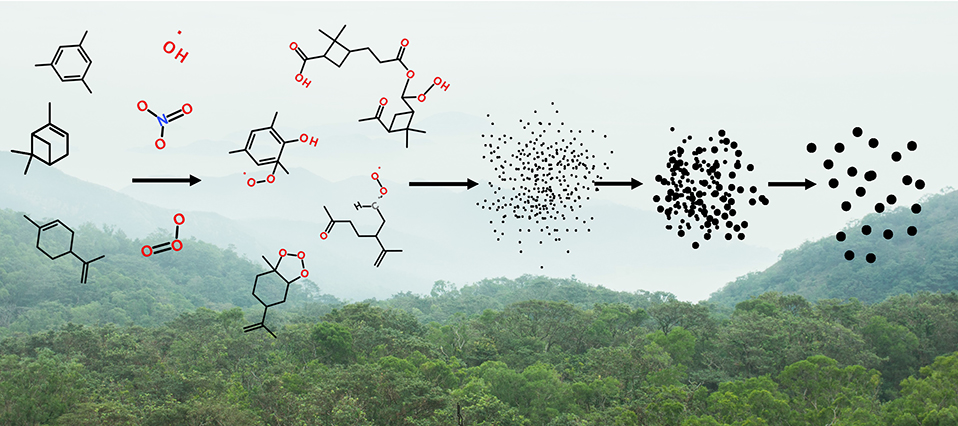
Illustration: Julia Hammes
In her thesis, Julia Hammes has studied a type of aerosol, particles in the air, called secondary organic aerosols. The particles included in this system form when gaseous organic compounds, emitted from plants or road traffic, oxidise in the atmosphere. When this happens, new particles can form or the existing particles can increase in size.
Can harm health and air quality
These secondary aerosols can be harmful to health, reduce air quality and impact the climate.
“For example, they have a cooling effect on the climate and can thereby mask some of the global warming caused by greenhouse gases. Their importance for the climate and their negative impact on air quality is a major reason to try to better understand how they are formed,” says Julia Hammes at the Department of Chemistry and Molecular Biology at the University of Gothenburg.
Have found new, previously unknown compounds in aerosols
Julia Hammes has studied atmospheric oxidation of several different compounds, such as alpha-pinene from conifers, trimethylbenzene from road traffic, limonene from citrus trees and fragrances used in cosmetics and cleaning products.
In her studies, she has used ultramodern high-resolution mass spectrometry to identify several previously unknown compounds that form when alpha-pinene, trimethylbenzene and limonene react in the air.
The compounds that formed were studied under many different experimental conditions.
 “Some of the compounds were identified only in their gaseous form. Our results show that nitric oxides can counteract these from oxidising further in the air and forming new particles. It is very interesting to see how different air pollutants impact each other and therebye formation of aerosols. If we understand the chemistry behind how aerosols form, we can more accurately estimate the amount and the impact on air quality and the climate in the future.”
“Some of the compounds were identified only in their gaseous form. Our results show that nitric oxides can counteract these from oxidising further in the air and forming new particles. It is very interesting to see how different air pollutants impact each other and therebye formation of aerosols. If we understand the chemistry behind how aerosols form, we can more accurately estimate the amount and the impact on air quality and the climate in the future.”
The dissertation’s title: Atmospheric Chemistry of Volatile Organic Compounds: Oxidation Products, Mechanisms and Secondary Organic Aerosol Formation
Link: https://gupea.ub.gu.se/handle/2077/58315
Supervisor: Mattias Hallquist
Contact: Julia Hammes, Department of Chemistry and Molecular Biology, University of Gothenburg, Ph. +46 (0)31-786 9074, e-mail: julia.hammes@gu.se
Alternative: Mattias Hallquist, Department of Chemistry and Molecular Biology, University of Gothenburg, Ph. +46 (0)31-786 9019, mobile: +46 (0)76-622 9019, e-mail: mattias.hallquist@gu.se
Photo: Christian Mark Salvador

 “Some of the compounds were identified only in their gaseous form. Our results show that nitric oxides can counteract these from oxidising further in the air and forming new particles. It is very interesting to see how different air pollutants impact each other and therebye formation of aerosols. If we understand the chemistry behind how aerosols form, we can more accurately estimate the amount and the impact on air quality and the climate in the future.”
“Some of the compounds were identified only in their gaseous form. Our results show that nitric oxides can counteract these from oxidising further in the air and forming new particles. It is very interesting to see how different air pollutants impact each other and therebye formation of aerosols. If we understand the chemistry behind how aerosols form, we can more accurately estimate the amount and the impact on air quality and the climate in the future.”